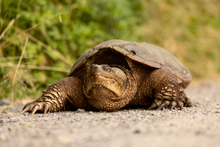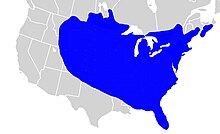Common snapping turtle
| Common snapping turtle | |
|---|---|

| |
| Snapping turtle crossing the trail at John Heinz NWR | |
| Scientific classification | |
| Domain: | Eukaryota |
| Kingdom: | Animalia |
| Phylum: | Chordata |
| Class: | Reptilia |
| Order: | Testudines |
| Suborder: | Cryptodira |
| Family: | Chelydridae |
| Genus: | Chelydra |
| Species: | C. serpentina
|
| Binomial name | |
| Chelydra serpentina | |

| |
| Native range map of C. serpentina | |
| Synonyms | |
| |
The common snapping turtle (Chelydra serpentina) is a species of large freshwater turtle in the family Chelydridae. Its natural range extends from southeastern Canada, southwest to the edge of the Rocky Mountains, as far east as Nova Scotia and Florida. The present-day Chelydra serpentina population in the Middle Rio Grande, suggests that common snapping turtle has been present in this drainage since at least the seventeenth century and is likely native.[3] The three species of Chelydra and the larger alligator snapping turtles (genus Macrochelys) are the only extant chelydrids, a family now restricted to the Americas. The common snapping turtle, as its name implies, is the most widespread.[4]
The common snapping turtle is noted for its combative disposition when out of the water with its powerful beak-like jaws, and highly mobile head and neck (hence the specific epithet serpentina, meaning "snake-like"). In water, it is likely to flee and hide underwater in sediment. The common snapping turtle has a life-history strategy characterized by high and variable mortality of embryos and hatchlings, delayed sexual maturity, extended adult longevity, and iteroparity (repeated reproductive events) with low reproductive success per reproductive event.[5]
Females, and presumably also males, in more northern populations mature later (at 15–20 years) and at a larger size than in more southern populations (about 12 years). Lifespan in the wild is poorly known, but long-term mark-recapture data from Algonquin Park in Ontario, Canada, suggest a maximum age over 100 years.[5]
Anatomy and morphology




C. serpentina has a rugged, muscular build with a ridged carapace (upper shell) that varies in color from tan, brown, and black,[6] although ridges tend to be more pronounced in younger individuals. The carapace length in adulthood may be nearly 50 cm (20 in), though 25–47 cm (9.8–18.5 in) is more common.[7] C. serpentina usually weighs 4.5–16 kg (9.9–35.3 lb). Per one study, breeding common snapping turtles were found to average 28.5 cm (11.2 in) in carapace length, 22.5 cm (8.9 in) in Plastron length and weigh about 6 kg (13 lb).[8]
Males are larger than females, with almost all weighing in excess of 10 kg (22 lb) being male and quite old, as the species continues to grow throughout life.[9] Any specimen above the aforementioned weights is exceptional, but the heaviest wild specimen caught reportedly weighed 34 kg (75 lb). Snapping turtles kept in captivity can be quite overweight due to overfeeding and have weighed as much as 39 kg (86 lb). In the northern part of its range, the common snapping turtle is often the heaviest native freshwater turtle.[10]

Ecology and life history
Common habitats are shallow
Snapping turtles are


Common snapping turtles have few predators when older, but eggs are subject to predation by
These turtles travel extensively over land to reach new
This species mates from April through November, with their peak laying season in June and July. The female can hold
Incubation time is temperature-dependent, ranging from 9 to 18 weeks. One study on the incubation period of the common snapping turtle incubated the eggs at two temperatures: 20 °C (68 °F) and 30 °C (86 °F). The research found that the incubation period at the higher temperature was significantly shorter at approximately 63 days, while at the lower temperature the time was approximately 140 days.[19] In cooler climates, hatchlings overwinter in the nest. The common snapping turtle is remarkably cold-tolerant; radiotelemetry studies have shown some individuals do not hibernate, but remain active under the ice during the winter.[18]
Common snapping turtle hatchlings have recently been found to make sounds before nest exit onto the surface, a phenomenon also known from species in the South American genus Podocnemis and the Ouachita map turtle. These sounds are mostly "clicking" noises, but other sounds, including those that sound somewhat like a “creak” or rubbing a finger along a fine-toothed comb, are also sometimes produced.[20][21]
In the northern part of their range snapping turtles do not breathe for more than six months because ice covers their hibernating site. These turtles can get oxygen by pushing their head out of the mud and allowing gas exchange to take place through the membranes of their mouth and throat. This is known as extrapulmonary respiration.[22]
If they cannot get enough oxygen through this method they start to utilize anaerobic pathways, burning sugars and fats without the use of oxygen. The metabolic by-products from this process are acidic and create very undesirable side effects by spring, which are known as oxygen debt.
Systematics and taxonomy
Currently, no subspecies of the common snapping turtle are recognized.[24] The former Florida subspecies osceola is currently considered a synonym of serpentina, while the other former subspecies Chelydra rossignonii[25] and Chelydra acutirostris are both recognized as full species.[24][26]
Behavior
In their environment, they are at the top of the food chain, causing them to feel less fear or aggression in some cases. When they encounter a species unfamiliar to them such as humans, in rare instances, they will become curious and survey the situation and even more rarely may bump their nose on a leg of the person standing in the water. Although snapping turtles have fierce dispositions,[27] when they are encountered in the water or a swimmer approaches, they will slip quietly away from any disturbance or may seek shelter under mud or grass nearby.[28]
Relationship with humans
As food
The common snapping turtle is a traditional ingredient in turtle soup; consumption in large quantities, however, can become a health concern due to potential concentration of toxic environmental pollutants in the turtle's flesh.[29]
Captivity
The common snapping turtle is not an ideal pet. Its neck is very flexible, and a wild turtle can bite its handler even if picked up by the sides of its shell. The claws are as sharp as those of
It is a common misconception that common snapping turtles may be safely picked up by the tail with no harm to the animal; in fact, this has a high chance of injuring the turtle, especially the tail itself and the vertebral column.[31] Lifting the turtle with the hands is difficult and dangerous. Snappers can stretch their necks back across their own carapace and to their hind feet on either side to bite. When they feel stressed, they release a musky odor from behind their legs.
It may be tempting to rescue a snapping turtle found on a road by getting it to bite a stick and then dragging it out of immediate danger. This action can, however, severely scrape the legs and underside of the turtle and lead to deadly infections in the wounds. The safest way to pick up a common snapping turtle is by grasping the carapace behind the back legs, being careful to not grasp the tail. There is a large gap behind the back legs that allows for easy grasping of the carapace and keeps hands safe from both the beak and claws of the turtle. It can also be picked up with a shovel, from the back, making sure the shovel is square across the bottom of the shell. The easiest way, though, is with a blanket or tarp, picking up the corners with the turtle in the middle.[citation needed]
Snapping turtles are raised on some
In politics

The common snapping turtle was the central feature of a famous
In 2006, the common snapping turtle was declared the
Reputation

While it is widely rumored that common snapping turtles can bite off human fingers or toes, and their powerful jaws are more than capable of doing so, no proven cases have ever been presented for this species, as they use their overall size and strength to deter would-be predators.[34] Common snapping turtles are "quite docile" animals underwater that prefer to avoid confrontations rather than provoke them.[34]
The ability to bite forcefully is extremely useful for consuming hard-bodied prey items such as mollusks, crustaceans, and turtles along with some plant matter, like nuts and seeds.
Invasive species
In recent years in Italy, large mature adult C. serpentina turtles have been taken from bodies of water throughout the country. They were most probably introduced by the release of unwanted pets. In March 2011, an individual weighing 20 kg (44 lb) was captured in a canal near Rome;[39] another individual was captured near Rome in September 2012.[40]
In Japan, the species was introduced as an exotic pet in the 1960s; it has been recorded as the source of serious bite injuries.[citation needed] In 2004 and 2005, some 1,000 individuals were found in Chiba Prefecture, making up the majority of individuals believed to have been introduced.[41]
Conservation
The species is currently classified as
Although common snapping turtles are listed as a species of least concern, anthropogenic factors still may have major effects on populations. Decades of road mortality may cause severe population decline in common snapping turtle populations present in urbanized wetlands. A study in southwestern Ontario monitored a population near a busy roadway and found a loss of 764 individuals in only 17 years. The population decreased from 941 individuals in 1985 to 177 individuals in 2002. Road mortality may put common snapping turtle populations at risk of extirpation. Exclusion fencing could aid in decreasing population loss.[43]
References
- ^ . Retrieved 4 December 2017.
- ^ "Appendices | CITES". cites.org. Retrieved 2023-03-01.
- .
- ISBN 9780801887246.
- ^ a b "COSEWIC Assessment and Status Report on the Snapping Turtle Chelydra serpentina" (PDF).
- PMID 9518475.
- ISBN 978-0-7894-7764-4.
- JSTOR 3893247.
- ^ doi:10.1139/z91-185.
- ^ a b Virginia Herpetological Society: Eastern Snapping Turtle Chelydra serpentina serpentina
- S2CID 78091420.
- ^ a b Hammer, D.A. (1972). Ecological relations of waterfowl and snapping turtle populations. Ph.D. dissertation, Utah State University, Salt Lake City, UT. 72 pg.
- S2CID 19542536.
- ^ a b "Chelydra serpentina (Common Snapping Turtle)". Animal Diversity Web.
- ^ Ernst, C.H., & Lovich, J. E. (2009). Turtles of the United States and Canada. Baltimore: Johns Hopkins University Press.
- PMID 25978736.
- ISSN 0179-1613.
- ^ a b "US Army Corps of Engineers, Engineer Research and Development Center, Environmental Laboratory: Common Snapping Turtle (Chelydra serpentina)". Archived from the original on 2013-03-31. Retrieved 2013-05-23.
- S2CID 37022680.
- ^ Geller, G.A.; Casper, G.S. (2019). "Late term embryos and hatchlings of Ouachita Map Turtles (Graptemys ouachitensis) make sounds within the nest". Herpetological Review. 50 (3): 449–452.
- ^ Geller, G.A.; Casper, G.S. (2019). "Chelydra serpentina (Snapping Turtle) hatchling sounds". Herpetological Review. 50 (4): 768–769.
- ^ a b Edqvist, ULf. "Tortoise Trust Web - Conservation and Ecology of Snapping Turtles". www.tortoisetrust.org. Retrieved 3 April 2018.
- ^ COSEWIC. "Species Profile - Snapping Turtle". Species At Risk Public Registry. Government of Canada. Archived from the original on 10 June 2013. Retrieved 24 February 2012.
- ^ ISBN 978-0965354097. Archived from the original (PDF) on 2011-07-17.)
{{cite book}}:|journal=ignored (help - ^ van Dijk, P.P.; Lee, J.; Calderón Mandujano, R.; Flores-Villela, O.; Lopez-Luna, M.A.; Vogt, R.C. (2007). "Chelydra rossignoni". IUCN Red List of Threatened Species. 2007. Retrieved 2009-05-04.
- ^ Chelydra, Reptile Database
- ^ Snapping Turtle, Encyclopedia.com
- ^ Common Snapping Turtle, Nature.ca
- ^ "Common Snapping Turtle: Interesting Facts". Department of Energy and Environmental Protection, State of Connecticut. DEEP (ct.gov). 8 November 2016. Retrieved 7 October 2017.
- ^ PlusPets Staff. (2020, October 24). Snapping Turtles: A Guide to Owning This Difficult Turtle Breed. PlusPets. http://pluspets.com/snapping-turtles/
- ^ Indiviglio, Frank (2008-06-24). "Handling Snapping Turtles, Chelydra serpentina, and Other Large Turtles". That Reptile Blog. That Pet Place. Retrieved 2008-07-20.
- ^ Fang Anning (方安宁), "“小庭院”养殖龟鳖大有赚头 Archived 2016-03-04 at the Wayback Machine" (Small-scale turtle farming may be very profitable). Zuojiang Daily (左江日报) (with photo)
- ^ Medina, Jennifer (2006-06-23). "A Few Things Lawmakers Can Agree On". N.Y./Region. New York Times. Retrieved 2008-07-20.
- ^ a b Kiley Briggs (July 11, 2018). "Snappers: The myth vs the turtle". The Orianne Society. Retrieved February 9, 2019.
- ^ LaGrange, S. M., Kessler, E. J., Li, Z., Morrissiey, F., & Merchant, M. (2023). Bite-Force Scaling across Size Classes in the Alligator Snapping Turtle (Macrochelys temminckii) and the Common Snapping Turtle (Chelydra serpentina). Southeastern Naturalist (Steuben, Me.), 22(sp12), 440–456. https://doi.org/10.1656/058.022.0sp1228
- ^ "7 things you need to know about snapping turtles". CBC News. June 16, 2015. Retrieved February 8, 2019.
- S2CID 54067445.)
{{cite journal}}: CS1 maint: multiple names: authors list (link - ^ J. Whitfield Gibbons (June 24, 2018). "Can a Snapping Turtle bite off a finger?". University of Georgia. Retrieved February 8, 2019.
- ^ "Una "azzanatrice" catturata fuori Roma". (March 17, 2011). Corriere della Sera. Milan.
- ^ "Tartaruga azzannatrice presa nel Tevere - Photostory Curiosità - ANSA.it". www.ansa.it. Retrieved 3 April 2018.
- ^ Desaki, Yotaro (5 August 2014). "Invasive snapping turtles on the rise in Chiba, other areas". thejapantimes news. Retrieved 15 May 2017.
- ^ Environment and Climate Change Canada (2016). Management Plan for the Snapping Turtle (Chelydra serpentina) in Canada [Proposed] (PDF). Species at Risk Act Management Plan Series. Ottawa: Ottawa, Environment and Climate Change Canada.
- S2CID 209338553.
External links
- The Snapping Turtle Page - www.chelydra.org
- Video: How to Help a Snapping Turtle Cross a Road, Toronto Zoo
- Snapping Turtle, Reptiles and Amphibians of Iowa
Further reading
- ISBN 0-394-50824-6. (Chelydra serpentina, pp. 435–436 + Plates 322–324).
- ISBN 0-395-19977-8(paperback). (Chelydra serpentina, pp. 37–38 + Plates 5, 11 + Map3).
- ISBN 0-7167-0020-4. (Chelydra serpentina, pp. 122, 142, 258).
- Linnaeus C (1758). Systema naturæ per regna tria naturæ, secundum classes, ordines, genera, species, cum characteribus, differentiis, synonymis, locis. Tomus I. Editio Decima, Reformata. Stockholm: L. Salvius. 824 pp. (Testudo serpentina, new species, p. 199). (in Latin).
- ISBN 0-307-13666-3. (Chelydra serpentina, pp. 38–39).
- Zim HS, Smith HM (1956). Reptiles and Amphibians: A Guide to Familiar American Species: A Golden Nature Guide. New York: Simon and Schuster. 160 pp. (Chelydra serpentina, pp. 19, 24, 155).
- Amtyaz Safi, Hashmi MUA and Smith JP. 2020. A review of distribution, threats, conservation and status of freshwater turtles of Ontario, Canada. Journal of Environmental sciences. 2(1) (2020): 36–41.

